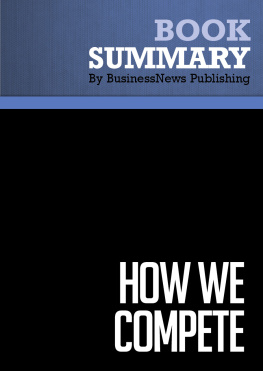BusinessNews Publishing - Summary: How We Compete: Review and Analysis of Bergers Book
Here you can read online BusinessNews Publishing - Summary: How We Compete: Review and Analysis of Bergers Book full text of the book (entire story) in english for free. Download pdf and epub, get meaning, cover and reviews about this ebook. year: 2013, publisher: Primento, genre: Politics. Description of the work, (preface) as well as reviews are available. Best literature library LitArk.com created for fans of good reading and offers a wide selection of genres:
Romance novel
Science fiction
Adventure
Detective
Science
History
Home and family
Prose
Art
Politics
Computer
Non-fiction
Religion
Business
Children
Humor
Choose a favorite category and find really read worthwhile books. Enjoy immersion in the world of imagination, feel the emotions of the characters or learn something new for yourself, make an fascinating discovery.
- Book:Summary: How We Compete: Review and Analysis of Bergers Book
- Author:
- Publisher:Primento
- Genre:
- Year:2013
- Rating:5 / 5
- Favourites:Add to favourites
- Your mark:
- 100
- 1
- 2
- 3
- 4
- 5
Summary: How We Compete: Review and Analysis of Bergers Book: summary, description and annotation
We offer to read an annotation, description, summary or preface (depends on what the author of the book "Summary: How We Compete: Review and Analysis of Bergers Book" wrote himself). If you haven't found the necessary information about the book — write in the comments, we will try to find it.
BusinessNews Publishing: author's other books
Who wrote Summary: How We Compete: Review and Analysis of Bergers Book? Find out the surname, the name of the author of the book and a list of all author's works by series.
Summary: How We Compete: Review and Analysis of Bergers Book — read online for free the complete book (whole text) full work
Below is the text of the book, divided by pages. System saving the place of the last page read, allows you to conveniently read the book "Summary: How We Compete: Review and Analysis of Bergers Book" online for free, without having to search again every time where you left off. Put a bookmark, and you can go to the page where you finished reading at any time.
Font size:
Interval:
Bookmark:


- Equal wages for the same work would be paid, regardless of where the worker is physically located.
- The market price of a good or service would be identical, regardless of where it was purchased.
- Interest rates would be the same around the world, being adjusted upwards or downwards only to allow for different levels of risk.
- China opening up its borders to trade with the West in 1979.
- The fall of the Berlin wall in 1989.
- Political decisions by the United States and other major world economic powers to liberalize capital markets and to remove trade restrictions, notably the 1947 General Agreement on Tarriffs and Trade and the 1986-1994 Uruguay Round of negotiations from 1986 to 1994.
- The decision to establish the World Trade Organization in 1994.
- The ongoing reduction in the costs of communication and transportation, fueled by new technologies.
- The liberalization of national financial markets including the unrestricted and unregulated ability to move large amounts of capital into and out of countries at will.
- Low-cost skilled or semi-skilled workforces.
- State-of-the-art manufacturing facilities.
- Skilled technicians who are innovative and experienced.
- Access to cutting-edge innovation and problem solving skills.
- The ability to rapidly scale up production without making large up-front capital investments.
- Shortened time-to-market and a compressed product development cycle.
- Ready-to-use modules and components which can be combined to make new products.
- Access to specialist firms who are world-class in their manufacturing techniques and operations.
- On-demand production capacity and other professional services, including marketing.
Font size:
Interval:
Bookmark:
Similar books «Summary: How We Compete: Review and Analysis of Bergers Book»
Look at similar books to Summary: How We Compete: Review and Analysis of Bergers Book. We have selected literature similar in name and meaning in the hope of providing readers with more options to find new, interesting, not yet read works.
Discussion, reviews of the book Summary: How We Compete: Review and Analysis of Bergers Book and just readers' own opinions. Leave your comments, write what you think about the work, its meaning or the main characters. Specify what exactly you liked and what you didn't like, and why you think so.


